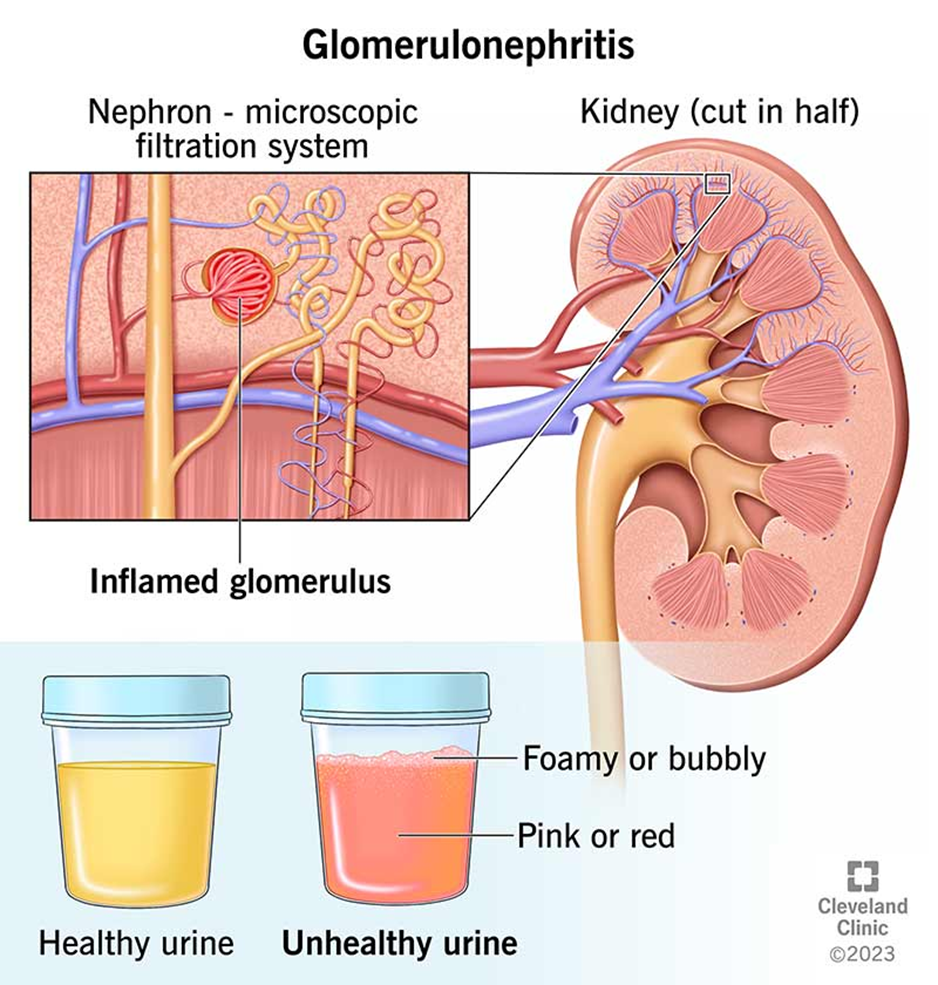A 6-year-old child is admitted with acute glomerulonephritis. What should the nurse expect the urinalysis to show during the acute phase?
Bacteriuria, increased specific gravity
Hematuria, mild to moderate proteinuria
Bacteriuria, proteinuria
High levels of proteinuria, decreased specific gravity
The Correct Answer is B
Choice A reason:
Bacteriuria, or the presence of bacteria in the urine, is not typically associated with acute glomerulonephritis. Acute glomerulonephritis is primarily an inflammatory condition affecting the glomeruli of the kidneys, and it does not usually involve bacterial infection. Increased specific gravity can occur due to concentrated urine, but bacteriuria is not a characteristic finding.
Choice B reason:
Hematuria, or blood in the urine, and mild to moderate proteinuria are characteristic findings in acute glomerulonephritis. Hematuria occurs due to inflammation and damage to the glomeruli, allowing red blood cells to pass into the urine. Proteinuria results from the increased permeability of the glomerular basement membrane, allowing proteins to leak into the urine. These findings are key indicators of glomerular inflammation and damage.

Choice C reason:
While proteinuria can be present in acute glomerulonephritis, bacteriuria is not a typical finding. The condition is primarily inflammatory rather than infectious, so the presence of bacteria in the urine is not expected. The focus should be on the inflammatory markers such as hematuria and proteinuria.
Choice D reason:
High levels of proteinuria and decreased specific gravity are not typical findings in acute glomerulonephritis. While proteinuria can occur, it is usually mild to moderate rather than high. Specific gravity may be increased due to concentrated urine, but decreased specific gravity is not a characteristic finding of this condition.
Nursing Test Bank
Naxlex Comprehensive Predictor Exams
Related Questions
Correct Answer is D
Explanation
Choice A reason:
Bilious vomiting and constipation are not typical manifestations of hypertrophic pyloric stenosis. Bilious vomiting, which is green or yellow, indicates that the vomit contains bile and is usually associated with intestinal obstruction beyond the stomach. Hypertrophic pyloric stenosis typically causes non-bilious, projectile vomiting because the obstruction is at the pylorus, before the bile duct.
Choice B reason:
Abdominal distention and currant jelly-like stools are not indicative of hypertrophic pyloric stenosis. Currant jelly-like stools are a classic sign of intussusception, a different condition where part of the intestine telescopes into itself. While abdominal distention can occur in pyloric stenosis, the presence of currant jelly-like stools points to a different diagnosis.
Choice C reason:
A rounded abdomen and hypoactive bowel sounds can be seen in various gastrointestinal conditions but are not specific to hypertrophic pyloric stenosis. While a rounded abdomen may be present due to gastric distention, hypoactive bowel sounds are not a hallmark of this condition. The primary symptom of pyloric stenosis is projectile vomiting.
Choice D reason:
Ravenously hungry after vomiting is a classic manifestation of hypertrophic pyloric stenosis. Infants with this condition often vomit forcefully after feeding and then appear hungry again because the food does not pass through the pylorus into the intestines. This symptom, along with projectile vomiting, is a key indicator of pyloric stenosis.
Correct Answer is ["B","C","D"]
Explanation
Choice A: Increase Sodium Intake
Increasing sodium intake is generally not recommended for patients with renal disorders. High sodium intake can lead to fluid retention, hypertension, and worsening of kidney function. Patients with renal disorders are often advised to follow a low-sodium diet to manage these risks.
Choice B: Monitor Intake/Output
Monitoring intake and output (I/O) is crucial for patients with renal disorders. It helps in assessing kidney function and fluid balance. Accurate measurement of fluid intake and urine output can provide valuable information about the patient’s hydration status and kidney function. This intervention is essential for preventing fluid overload and dehydration.
Choice C: Daily Weights
Daily weights are an important intervention for patients with renal disorders. Monitoring weight daily helps in detecting fluid retention early. Sudden weight gain can indicate fluid overload, which is a common issue in patients with kidney problems. By tracking daily weights, healthcare providers can make timely adjustments to the patient’s treatment plan.
Choice D: Monitor Blood Pressure
Monitoring blood pressure is a key intervention for patients with renal disorders. Hypertension is both a cause and a consequence of kidney disease. Regular monitoring of blood pressure helps in managing hypertension and preventing further damage to the kidneys. It also aids in assessing the effectiveness of antihypertensive medications.
Whether you are a student looking to ace your exams or a practicing nurse seeking to enhance your expertise , our nursing education contents will empower you with the confidence and competence to make a difference in the lives of patients and become a respected leader in the healthcare field.
Visit Naxlex, invest in your future and unlock endless possibilities with our unparalleled nursing education contents today
Report Wrong Answer on the Current Question
Do you disagree with the answer? If yes, what is your expected answer? Explain.
Kindly be descriptive with the issue you are facing.
